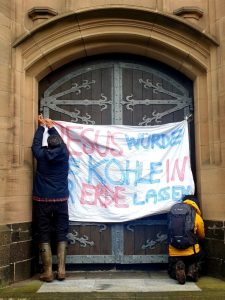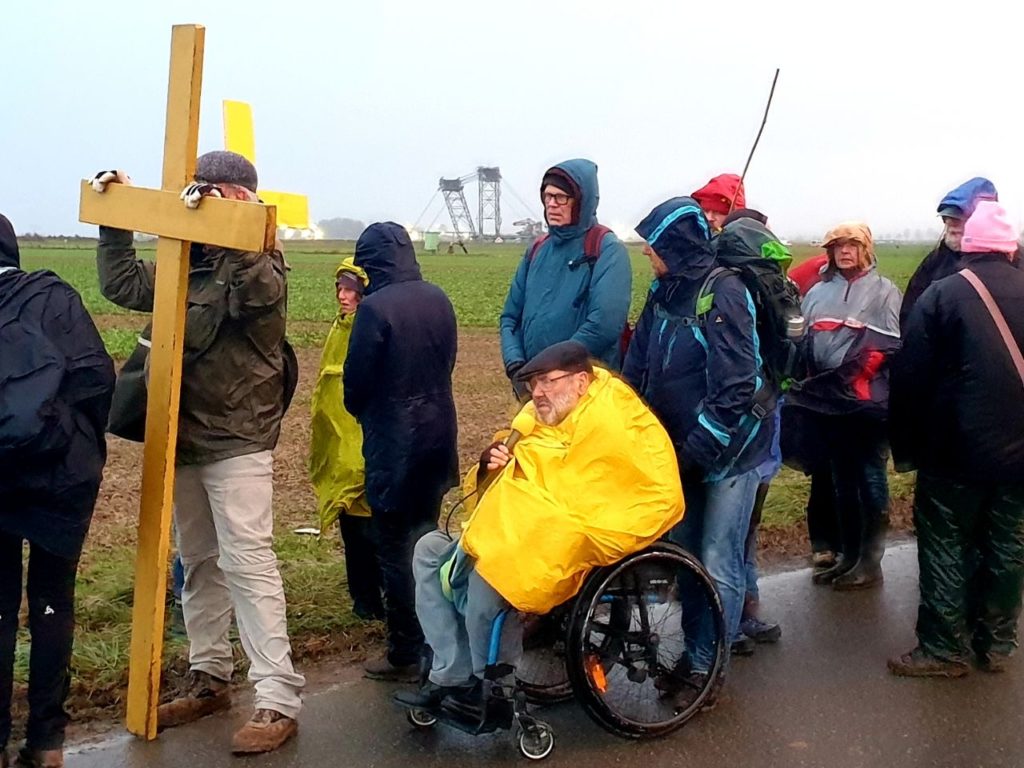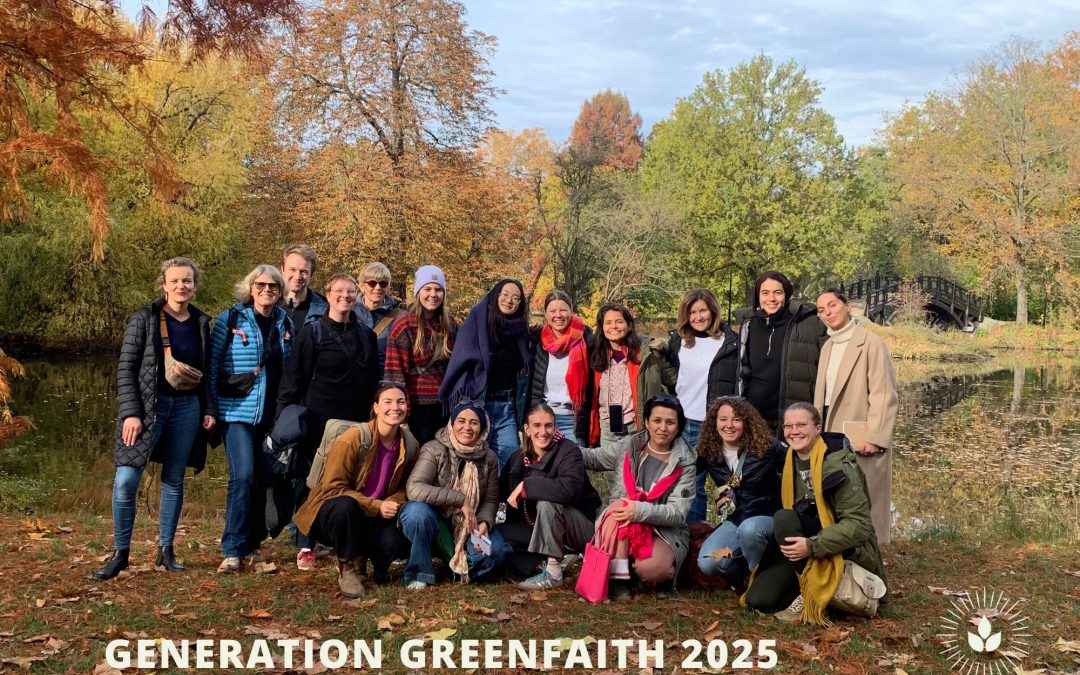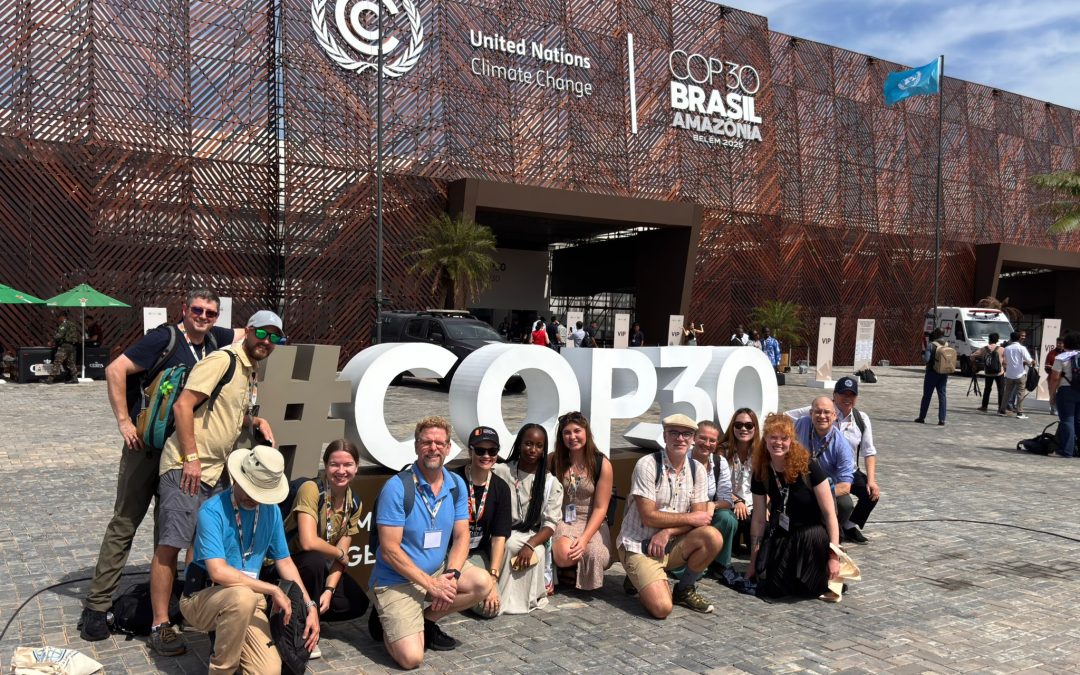by Sandra Prüfer
Lützerath/Bonn, 30.01.2023
The German phrase “Die Kirche im Dorf lassen” (to leave the church in the village) has a
similar meaning to the English expression “don’t get carried away”. It is said to originate
from Catholic processions in which a church congregation crossed the village boundary
during its procession. This was not welcomed by villagers in neighboring communities.
When they then said “leave the church in the village” to express their displeasure, they
meant please “don’t exaggerate”, “stay grounded” and within your borders.
A few weeks ago, I traveled from Bonn, host city of the UN climate secretariat, to the rural
Rhenish coal mining region, which is Germany’s largest coal mining area, operated by the
energy company RWE, and Europe’s biggest CO2 polluter.
On January 13, I join a small procession behind a yellow cross from the village of
Keyenberg towards the neighboring village of Lützerath, located about 3.5 kilometers away.
The about 30 procession participants want to express their solidarity and displeasure about
the on-going demolition of the neighboring village on the edge of the Garzweiler coalfield,
which has become a symbol of the global climate movement. Together they want to pray
and sing for the integrity of creation and for a peaceful and non-violent conflict resolution.
Inside and outside – united in prayer
The ecumenical Christian grass-roots initiative “Leave the church(es) in the village” (KiDl)
had invited to this service at the fence under the motto “Inside and outside – united in
prayer”. It was the third day of the forceful eviction of Lützerath, with dozens of climate
activists still holding out in occupied houses, tree houses and an underground tunnel. By
now, the hamlet had been taken over by the police and completely fenced off. Access to the
inside was therefore no longer possible.
The meeting point for the service is at 3 pm in front of the church in Keyenberg. Church
services are no longer celebrated inside the church, because RWE Power AG has been
since 2019 the owner of the Holy Cross Church, which is one of the ten oldest churches in
Germany mentioned in a document. On November 28, 2021, the church was deconsecrated
with the approval of the Bishop of Aachen. Prior to that, the bells were removed from the
church tower. All the more surprising to hear at the beginning of the open-air service the
sounds of its old carillon – over loudspeakers, from the still inhabited former
rectory.
Despite the stormy weather, more than 25 believers and climate activists gathered for the
worship service. A couple adorned the shuttered church door with a banner reading “Jesus
would leave the coal in the ground.”
Local participants reported that the “Eibenkapelle”, an outdoor chapel surrounded by yew
trees and a place of worship of the KiDl community, was among the first to be evicted by
RWE and police forces. Located on a former beautiful tree-lined country road, it was
once the site of a wayside cross, perhaps also a wayside chapel, as local KiDl members had
researched. Anselm Meyer-Antz, the spokesperson of the initiative, explains that the
property was donated to the Catholic parish of Immerath from the predecessors of
Lützerath’s last farmer, Eckardt Heukamp, who had been driven out in the meantime. Over a
long period of time, Heukamp had stubbornly resisted his expropriation for the sake of dirty
open-cast coal mining. Last spring, however, he saw himself with a heavy heart forced to
sell his 18th-century farm and farmland to RWE, after a Higher Administrative Court had
ruled that the energy giant was allowed to excavate his property. – “But, according to the
land register the chapel site is still the property of the local Catholic parish community,”
Meyer-Antz explains. A handful of Christian protesters tried to watch over and protect the open-
air chapel as a “place of liberating and ecological spirituality” until they were forcibly
removed by police forces.

Gläubige Menschen von Die Kirche(n) im Dorf lassen hängen ein Banner auf.
Watch and pray for Lützerath
The service is led by Manfred Esmajor, a retired Catholic priest from the region. At the
beginning he reads the parable of the fig tree (New Testament, Gospel of Mark chapter 13,
28 et seqq), in which he sees parallels to the evacuation of Lützerath. Riding in a wheelchair,
he leads the procession, from the church out onto the country road L12, past empty houses.
With a microphone and amplifier on his lap, he sings with the congregation the Taizé song
“Stay here and watch with me – watch and pray”; – Jesus’ invitation to his disciples in the
Garden of Gethsemane.
Shortly before leaving the village, the procession is stopped by the police to let a group of
climate activists, including from Greenpeace and Scientist Rebellion, pass by. They had set
off from the opposite direction in the newly established vigil in the nearby village of
Holzweiler by the coalition “Alle Dörfer bleiben” (All villages must remain)”.
Keyenberg is one of the five “saved” villages that the federal government, the state of North
Rhine-Westphalia (NRW) and RWE agreed to preserve in their 2030 NRW coal phase-out
deal. Only about 60 of the once 900 inhabitants still live in Keyenberg. Following the
intermission, pastor Esmajor reads out the names of the villages that have already been
bulldozed and dredged by RWE’s Garzweiler coal mining. “Your kingdom of justice come”
the congregation responds.
Lützerath marks the 1.5 degree red line
On the country road, one can see the huge RWE excavator in the distance, inexorably
approaching Lützerath, as well as wind turbines. Rain and gusty winds whip across the
fields. Right here, the climate activists say, is the 1.5 degree line that must be defended to comply with the national climate protection law and the goals of the international Paris Agreement – to avoid the worst effects of global warming.
The initiative “Leave the church(es) in the village” was born in 2018 out of local resistance
against the people-hurting and climate-damaging open-cast mining. At the time, pictures of
the destruction of the St. Lambertus Church, locally known as
“Immerather Dom” went around the world, and four other churches were threatened with
demolition. The initiative is not only committed to preserving the cultural heritage of century-
old villages, their churches and chapels, and extremely fertile farmland in the Rhineland, but
also sees its efforts as inseparably linked to the fight for global climate justice.
Pastor Esmajor reports from Congo as an example. For the Congolese people and
communities with whom he works with, the consequences of climate change have long been
felt. Weather extremes, droughts and floods are becoming more frequent. In December, at
least 120 people were killed by floods and landslides in the capital Kinshasa alone.
At the turning point of the procession, the participants have the opportunity to express their
concerns and feelings and to say intercessions. One woman recalls the many animals and
plants that have lost their habitat in Lützerath, another points out the health hazards of
opencast mining due to fine dust pollution and radioactivity. Some express their
concerns about the consequences of RWE’s fossil fueled expansion on the world’s climate,
others their hope for a moratorium on coal mining under Lützerath.
Talking to each other instead of evicting
They draw hope from the announcement by Antje Grothus, a Green member of the state
parliament and environmental activist friend, that the currently approved operating plan for
the Garzweiler open pit mine includes areas whose owners did not want to sell to RWE.
Thus, there was a threat of protracted and legally uncertain expropriations in the planned
mining area and near future even after Lützerath’s eviction. “Open pit mining could thus
come to a standstill a few hundred meters behind Lützerath”, she said in the press release
published the day before. “We now have to talk instead of clearing”, Grothus said.
Anselm Meyer-Antz reports that his employer Misereor has also taken a stand and is calling
on all parties involved in the conflict to remain calm. The Catholic aid agency for international
development cooperation is calling on the state government for an immediate moratorium on
the Lützerath eviction in order to resolve the conflicts of interest between all stakeholders,
compliance with the 1.5 degree climate target and concerns about the national energy
security. The interests of the Global South must also be taken into account.
“The root cause of the climate emergency is fossil fuels”, stressed Meryne Warah, global
organizing director of Nairobi-based GreenFaith, in the statement. “For the sake of life and
to prevent massive suffering, in Africa and the entire world, we need a binding global
agreement to stop all new fossil fuel expansion projects, phase out of existing production,
and provide generous support for communities to transition to a clean energy future and
universal access to clean, affordable energy.”

Prozession von KiDl in Lützerath.
The Yellow Cross: From Gorleben to Lützerath
On the way back to Keyenberg, I talked with Michel Friedrich, a teacher from Wedel near
Hamburg, who was engaged in the anti-nuclear movement in his youth. For him, the nuclear
and coal phase-out belong together.
Friedrich and his wife Bina also joined the “Way of the Cross for Creation” from Gorleben to
Lützerath in the summer of 2021. A broad alliance of climate and environmental initiatives,
Christian groups and church institutions had called for this pilgrimage walk under the motto
“anti-nuclear meets anti-coal”. A 1.80-meter yellow wooden cross was carried in 26 stages
nearly 500 kilometers to the edge of the Garzweiler open pit mine, past the now
decommissioned Grohnde nuclear power plant, the Tönnies meat factories, the Datteln 4
coal-fired power plant, the RWE headquarters in Essen and the state government in
Düsseldorf. The Christian climate activation was a reference to the legendary 1988 “Way of
the Cross for Creation” walk from the then anti-nuclear hotspots Wackersdorf to Gorleben –
as an expression of the inter-coherence of the struggles and the solidarity of environmental
activists in various locations.
On August 1, 2021, the yellow Cross, donated by the Gorleben prayer initiative,reached its
destination. It was was placed in Lützerath at the Eibenkapelle. “We put up this cross as a
symbol of hope against the destruction of the creation, which is hardly more tangible
anywhere than at this gigantic hole”, said Cornelia Senne, theologian and member of the
initiative “Leave the church(es) in the village” at the time.
Eibenkapelle 2.0 – A Sign Of God?
Ralf Meister, the Protestant church bishop from Hanover, described the discovery of the
chapel property in the summer of 2021 – a 40 square meter enclosure with four steps,
circled by yew trees – as a “hint from God”.
In the open-air chapel, decorated with the Gorleben cross, candles and flowers, regular
services were held until a few days ago. In the meantime, the chapel has been cleared and
all yew trees cut down. But its foundation still stands.
And what happened to the cross from Gorleben?
“It was taken into custody by the police”, Meyer-Antz says. According to eyewitnesses, a
police officer “respectfully” carried the cross away. Efforts are now under way to locate and
recover it.
“The chapel was a meeting place for people from near and far who feel connected to the
Christian climate movement. It will not only live on in our spirit. There will certainly be an
Eibenkapelle 2.0″ says Meyer-Antz.
Following the eviction of the chapel, Anna-Nicole Heinrich, President of the Synod of the
Evangelical Church in Germany (EKD), expressed her solidarity with the climate activists
and chapel guardians in Lützerath in an Instagram post. “In recent months, the Eibenkapelle was an ecumenical place for all people for silence, to pause, to pray. To admire and marvel at God’s creation, to think about how to become better stewards of our common home”,
Heinrich wrote.
She thanked all those engaged in the nonviolent fight for climate protection, for climate
justice, for the integrity of creation. In prayer, on the street and in politics. “We need places
like the Eibenkapelle that give us hope and strength to take courageous action against the
climate catastrophe we are racing towards.”
Keep the human in check
The procession ends at the church in Keyenberg with a common prayer and singing. The
participants, standing in a circle, hold each other’s hands. Despite their sadness and irritation
about the aggressive behavior of the police force during the eviction, they want to continue their
non-violent protest against lignite coal mining and take part in the large-scale demonstration on
Saturday.
Pastor Esmajor invites me to read as a last service contribution from the environmental
psalm “The Earth Groans”, written by Monsignor Stephan Wahl. I brought the text with me from Bonn as an inspiration for the occasion. It is taken from the book
“Expect no pious sayings from me”. The last verses of the psalm read:
“But not all of them are committing treason against your glorious creation.
Strengthen the brave and the resistant in their loud protest.
May your blessing be with all, who without fuss, yet consistently,
live sustainably, preserve the world where they are.
Because our children and their offspring should also be granted,
to marvel at the richness of your diverse creation.
Blessed are you, Eternal One, Creator of days and nights,
preserve the world and keep mankind in check.”




